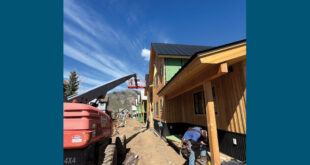Carbon neutrality gets dropped, for now
The Gunnison Board of County Commissioners (BOCC) is poised to adopt the Special Development Project Resolution at their regular meeting on Tuesday, September 1, putting an end to a process of writing and revising the document that started more than three years ago.
During that time, meetings of the Planning Commission, and sometimes the BOCC, turned out four major versions of the Resolution, or SDPR, and now a fifth version will set the development standard for “mega-projects” being proposed in the county.
“Unlike many things that come to us in public hearings, when we still need to learn about the issue, this isn’t the case here. We’ve participated in joint meetings with the Planning Commission throughout the process,” commissioner Hap Channell said. “I think we understand this document pretty well.”
For the most part, the members of the public speaking at the hearing sang a familiar refrain for the commissioners, no matter what side of the issues they were on. The commissioners, having heard the arguments before, made only one major revision to the SDPR recommended by the Planning Commission.
They dropped the requirement that projects applying under the resolution be carbon neutral, at least for now. (See sidebar story on pg. 13)
There are two projects being considered in the county that would fall under the scope of the SDPR. Proponents for both spoke out against the inclusion of the carbon neutrality requirement.
One of those mega-project proponents, the Mt. Emmons Moly Company, repeated its concerns in a letter to the commissioners about the constitutionality of the SDPR, along with concerns about the “breadth, arbitrary nature and ambiguity of many of the provisions.”
They also questioned the Planning Commission’s decision to drop “any Commissioner level appeals process for disputes that are likely to arise during the course of permitting a Special Development Project.”
The letter from Mt. Emmons Moly Company director of community relations Perry Anderson says, “It appears that the Planning Commission wishes that any dispute that may arise during the permitting process … be resolved in a court of law.”
Special counsel to the county Barbara Green pointed out that there is a focus on the reapplication process when proponents will be able to meet with county staff to work through many of the problems that might otherwise be addressed through appeal.
“There are several internal safety valves that would allow for the conversation between the two without the cumbersome process there was before,” Green said.
Crested Butte Mountain Resort, which also has a project in-waiting that could need to go through the SDPR process, weighed in with a letter of its own outlining several concerns, including the provision for carbon neutrality and the county’s assertion that it has authority to govern private projects on federal land.
“Applied literally, the Resolution provides that the County can veto recreational development on federal lands authorized by the Forest Service by withholding a permit,” the letter says. “The County does not have that authority under settled law.”
The county has contended from the beginning that it does have the authority to apply its standard to projects on federal land, as long as those projects are of state significance. They point out that the federal process for reviewing those projects does not consider any off-site impacts of the projects.
But for areas where the federal and county processes do overlap, the county has said that it is willing to accept work that was done for the feds in the permitting process.
“We are very much in support of the integration with the NEPA [National Environmental Policy Act] process for environmental review that is mentioned in the resolution,” CBMR vice-president of resort planning and development Michael Kraatz said. “We think it’s a great direction. We just ask that it is required by the resolution that the county process be integrated with NEPA.”
CBMR’s stated hope is that the SDPR will become less “burdensome, expensive and time-consuming,” if NEPA integration is required.
Several people speaking at the public hearing echoed county resident Butch Clark’s request that the commissioners consider the off-site impacts of large projects. Planning commissioner Ramon Reed asked that the county pursue some language in the SDPR that would engage the local municipalities in the application review, so there would be some consideration for everyone that might be effected.
Commissioner Hap Channell said he wanted to have a more in-depth conversation about carbon neutrality before requiring it of applicants under the SDPR, but felt the rest of the document was in order.
County attorney David Baumgarten was directed to draft an amendment that could replace the carbon neutrality provision with one that requires projects to meet the county’s current environmental standards.
The commissioners agreed that such an arrangement would lead to further conversations about how the county’s standard can be improved to reduce greenhouse gas emissions at all levels of development.
The resolution to approve the SDPR as amended will be considered by the commissioners at their regular meeting on Tuesday, September 1.
 The Crested Butte News Serving the Gunnison Valley since 1999
The Crested Butte News Serving the Gunnison Valley since 1999

